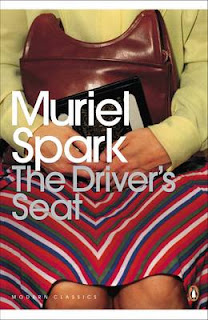Strangely enough, I have more short fiction to share with you today. I guess these are what would be called "novellas": The Driver's Seat and The Finishing School, both by Muriel Spark.
If I were at all smart, I would not be talking about two
books in one post. It should be pretty obvious that I need all the
material I can get these days; with my return to the US looming in the
very near future, I've been reading more scholarly stuff and spending my
time on the trains staring at the ads fretting (and frankly the future
forecast looks like more of the same). The highlight of my bookly life
lately has been recommending a book to The Manolo (!).
But it's best for you the reader if I talk about these two short books together, and I am all about you the reader and that's why you love me. Ahem.
The Driver's Seat
is a creepy, creepy little story: there's a lot that's off and
unsettling but I couldn't quite put it all together until the very end.
Whereas...
The Finishing School
is lower-key, featuring two characters who are obsessed with each
other, and how their obsession grows and impacts the rest of the
community. The Driver's Seat was first published in 1970, and The Finishing School in 2004. The Finishing School
understandably has that little bit of unreality about the way it
portrays its young adult characters. It's hard to put a finger on any
particular scene or detail that's wrong; although the characters have
cell phones and laptops it just doesn't quite feel organic. Really the
effect is to make the time frame of the novel feel vague, which is not
such a bad thing.
Reading these two novels... novellas... really brought out an
interesting characteristic of Sparks' writing, which is the way she
plays with the timeline and with what you know and don't know. For
example, in The Driver's Seat, she states fairly early on that
Lise will soon be found murdered. She doesn't hint; she states; it's not
so much foreshadowing as foretelling. She does this in The Finishing School
as well, and there she also will abruptly move into a scene with two
characters discussing something whom you wouldn't expect together. Then
the camera moves back, so to speak, and Sparks tells you that they're
discussing the matter in bed, and they've been sleeping together for the
last several weeks. It's an interesting technique, and I think it
helped keep both these shortish stories moving.
The Driver's Seat is part of the Penguin "Modern Classics"
series and has an introduction -- which is actually really good. Or
maybe I'm just saying that because the author tells you to stop reading
at a certain point if you don't know the story already. Thanks,
introduction writer! It was one of the hard lessons I had to learn at
some point in my grown-up reading career, that "introductions" despite
the name are rarely any good for someone reading the book for the first
time. Ok, maybe that's an exaggeration. But it's an exaggeration I stand by.


I see what you did with that title.
ReplyDeleteI've read...two books by her? No, three. And the only one I really liked was The Abbess of Crewe. She seems to really go for these female authority figures who come unhinged, and I don't know how to feel about that. Other than slightly uncomfortable. But she has her hilarious moments, which are a-ok by me.
That's interesting; because I think the introduction to TDS (too lazy to type) mentions this authority-figure thing, and yet neither of these really has that as a feature. I guess Lise is sort of a controlling female but in the context of the story she's a tourist. And TFS has two male characters at the center.
DeleteIntroductions are just GIANT, sneaky spoilers of everything that is good and holy in the world. I, too, stand by your exaggeration.
ReplyDeleteSOLIDARITY
Delete